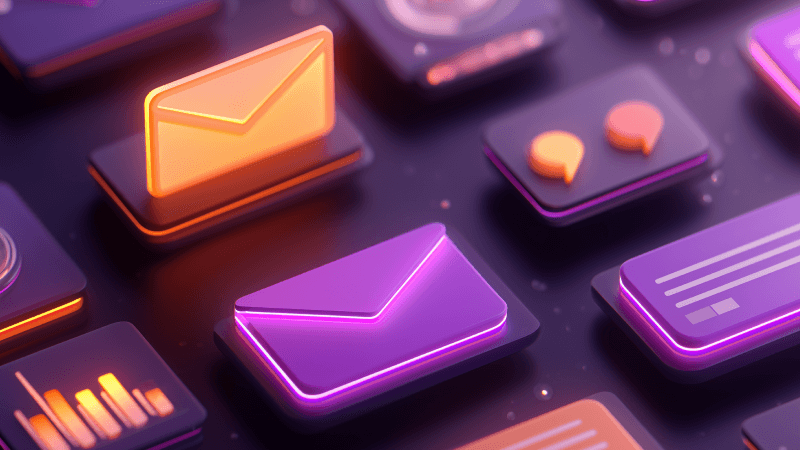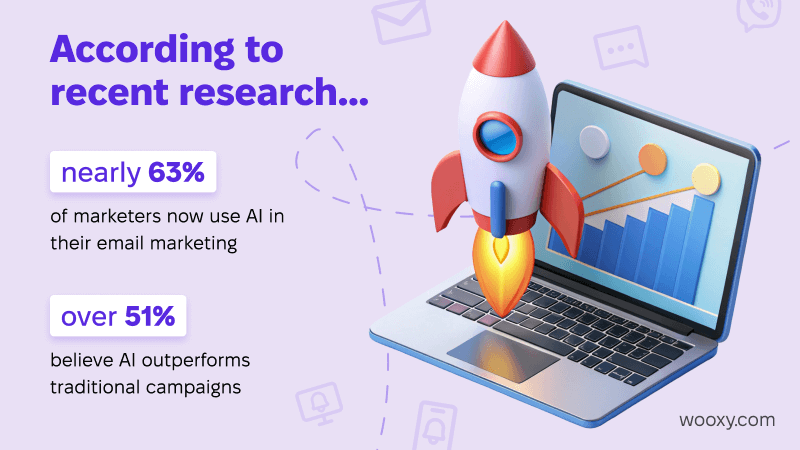Revolutionizing Email: How AI Is Changing the Game for Marketers
Email marketing has long been a trusted way to engage customers — but thanks to AI email marketing, we're entering a new era. AI can now write content, choose send timings, personalize messages — and automate complex workflows. Platforms like Wooxy integrate email, SMS, and more, offering campaign suggestions, one-click creation, pre-built blueprints, and measurable execution — all powered by Artificial Marketing Intelligence (AMI).
What Is AI Email Marketing?
AI email marketing uses artificial intelligence to streamline and enhance campaigns. It can generate subject lines, craft messages, segment audiences, and tailor content to individuals. This approach—also known as email marketing automation with AI — helps ensure the right message reaches the right person at the right time.
Wooxy takes it further: not only building campaigns, but also offering daily AI-generated ideas and one-click launches using blueprint templates. It's campaign strategy in minutes, not hours.

Why Personalized Email Marketing Matters
Consumers today expect brands to understand their preferences and respond accordingly. In fact, research shows that emails with personalized subject lines are 26% more likely to be opened, and personalized content can boost click-through rates by over 45%. What does personalization mean in this context? It goes far beyond using a first name in the subject line. True personalization includes:
- Sending relevant product recommendations based on browsing history.
- Triggering emails after specific customer actions (like cart abandonment).
- Adjusting tone and timing depending on the customer’s behavior and lifecycle stage.
When done well, personalization helps customers feel understood — not targeted. It reduces friction and increases trust.
This is where AI steps in. With the help of machine learning and automation platforms like Wooxy, businesses can analyze customer data in real time and deliver hyper-personalized emails automatically.
AI-powered personalization tools can:
- Analyze user behavior to identify interests and intent.
- Predict future purchases based on past actions.
- Adjust timing by determining when a user is most likely to open and engage.
- Continuously optimize email content and design through A/B testing without human input.
For example, if a user frequently browses gold rings but never clicks on diamond pieces, AI can automatically exclude diamond offers and highlight gold ring promotions in their future emails.
Real Examples of Email Personalization in Action
Here are a few practical examples to help you visualize what personalized email marketing looks like:
Dynamic Subject Lines
Instead of a generic “Check out our new arrivals,” try:
- “Just in: Gold rings you'll love, Anna”
- “Looking for something special in size 7?”
These subject lines pull real data (name, browsing preferences, size filters) to increase relevance and open rates.
Product Recommendations
AI can automatically suggest items based on browsing and purchase behavior.
Example:
- If a customer bought a necklace last month, an email may recommend matching earrings with a message like: “Complete your look with these handpicked pieces.”
Behavior-Triggered Emails
Abandoned cart emails are a classic.
But instead of a bland reminder, a personalized version might say:
- “Still thinking about that sapphire ring? It’s almost gone!”
- Add urgency and relevance by showing the exact product left behind, with real-time inventory status.
Birthday or Anniversary Offers
These simple but powerful touches show customers you’re paying attention.
- “Happy Birthday, Sarah! Enjoy 15% off your favorite pieces this week.”
- Combine this with personalized product picks based on past purchases to maximize conversion.
Location-Based Content
Use geolocation to tailor your emails. For example:
- “New arrivals now available in our NYC store – book your visit!”
- Or display local weather-driven product recommendations like cozy wear in colder regions.
Personalization is no longer optional — it’s expected. With the help of AI, brands of all sizes can move beyond basic segmentation to deliver truly meaningful, relevant experiences. Whether you're just starting out or looking to scale, adopting personalization into your email marketing will lead to stronger customer relationships and better results.

How AI Improves Customer Engagement
AI isn’t just about automation — it’s about building relationships. Predictive email marketing AI improves engagement by:
- Anticipating which content performs best
- Sending at the vote peak time for each subscriber
- Monitoring engagement and adapting future sends
These strategies help reduce churn, improve loyalty, and lift open rates. For example, brands using AI-driven personalization see up to 41% higher click-through rates and a 41% increase in revenue.
Real-World Case Studies
Netflix
Netflix has become a global leader in streaming not just because of its vast library, but also because of how effectively it uses AI to personalize the viewing experience. Its recommendation system analyzes each user’s behavior — what they watch, when they pause, what they rewatch, and even the genres they prefer — to suggest shows and movies that feel individually curated. This personalization extends to email marketing as well: Netflix sends tailored email prompts that remind users of unfinished shows, highlight new releases similar to their past choices, and promote trending titles within their preferred categories. By making every interaction feel relevant, Netflix keeps users consistently engaged and reduces subscriber churn, proving how powerful personalized email strategies can be in strengthening customer loyalty.
BMW (through Newbold BMW)
BMW, through its dealership partner Newbold BMW, provides another compelling example of AI-driven email marketing in action. The dealership harnessed AI tools to craft personalized campaigns that targeted nearly 10,000 potential car buyers. These emails weren’t generic blasts; they were designed with tailored messaging that spoke directly to customer interests and purchase intent. The results were remarkable: a 57% open rate — far above typical automotive industry averages — and an impressive 36.7% lead-to-shopper conversion rate, which translated to performance that was roughly 272% higher than standard benchmarks. Even more striking, the campaign delivered a 27x return on investment within just six months, highlighting how AI-powered personalization can drive not only engagement but also measurable revenue growth.
These examples from Netflix and BMW illustrate that even globally recognized brands with very different industries — entertainment and automotive — are thriving by integrating AI into their email marketing strategies. By focusing on personalization, relevance, and timely communication, they’re able to foster stronger customer connections, boost engagement rates, and achieve conversions well above industry norms.
The Future of AI Email Marketing
AI continues to evolve, and the future is exciting:
- Fully automated multi-channel campaigns
- Conversational email and SMS interactions
- Predictive content tailored to customer needs — even before they voice them
Companies of all sizes can now compete, innovate, and grow using AI-powered email marketing tools.
According to recent research, nearly 63% of marketers now use AI in their email marketing, and over 51% believe AI outperforms traditional campaigns. Nearly 47% use AI to generate entire campaigns. These tools also improve open rates by up to 41% and click-throughs by 13%, and boost revenue by 41%

Final Thoughts: Make Every Message Count
AI in email marketing isn’t just about saving time — it’s a strategic advantage. With smarter automation, personalized messaging, and real-time optimization, AI drives deeper engagement and results.
Wooxy makes AI accessible — no dashboards, no data overload. Just smarter campaigns that deliver real ROI. Ready to explore? Check out Wooxy’s Email Builder or visit the Blueprint Marketplace to see how easy launching smarter campaigns can be.




